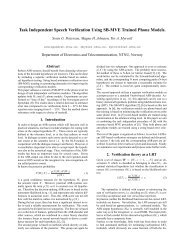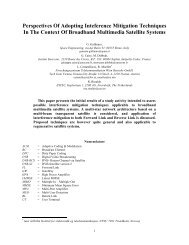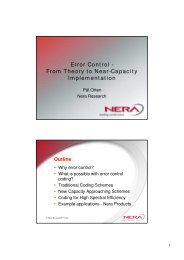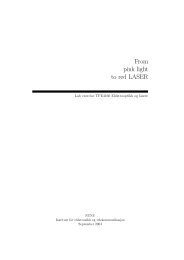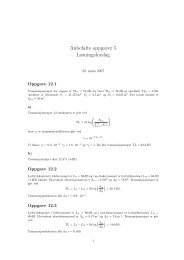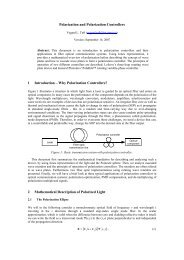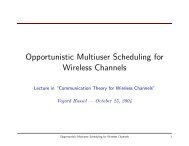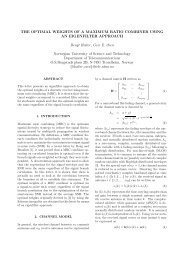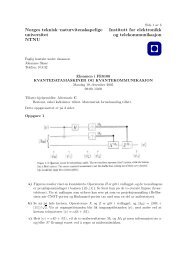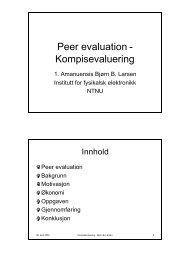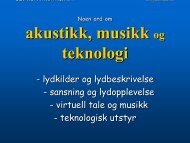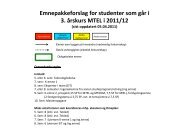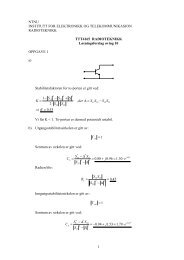LDPC CODED ADAPTIVE MULTILEVEL MODULATION ... - NTNU
LDPC CODED ADAPTIVE MULTILEVEL MODULATION ... - NTNU
LDPC CODED ADAPTIVE MULTILEVEL MODULATION ... - NTNU
Create successful ePaper yourself
Turn your PDF publications into a flip-book with our unique Google optimized e-Paper software.
performances are very similar. This rather counterintuitive<br />
behaviour can be attributed to the fact that<br />
the ARQ system has higher spectral efficiency in the<br />
transition regions when the CSNR values are small,<br />
as witnessed by Figure 4. Stated simply, the system<br />
can transmit at a higher average rate when we allow<br />
for retransmission, and the rate reduction which<br />
comes as a result of retransmissions does not destroy<br />
all of this spectral efficiency gain. The mechanisms<br />
behind this property are not yet fully explored, but<br />
some results indicate that they may be influenced by<br />
the number of non-zero elements in the codes’ parity<br />
check matrices.<br />
7. CONCLUSIONS<br />
Our results indicate that adaptive block-coded modulation<br />
has the potential of offering significantly better<br />
bandwidth efficiency than what is the case in today’s<br />
wireless systems, as long as the channel variations are<br />
not too rapid. We believe that the choice of <strong>LDPC</strong><br />
codes as component block codes in such a system are<br />
among the most promising possible choices.<br />
In addition, the observation that a zero-error system<br />
(bybrid FEC-ARQ) slightly outperforms a nonzero-error<br />
(FEC) system—regarding spectral efficiency—<br />
suggests that using <strong>LDPC</strong> codes in conjunction with<br />
ARQ may reduce the need for code concatenation<br />
(e.g., outer Reed-Solomon codes) to reduce the target<br />
BER further. More work is needed on the performance<br />
degradations experienced when the idealized<br />
assumptions of a perfect, zero-delay return channel<br />
and perfect channel estimation are relaxed.<br />
8. ACKNOWLEDGMENTS<br />
This paper is a summary of the M. Sc. E. E. theses<br />
(diploma projects) of V. Markhus [7] and B. Myhre<br />
[8], with G. E. Øien as supervisor. The authors would<br />
like to thank Senior Research Scientist P. Orten (Nera<br />
Research) and Professor K. J. Hole (Univ. of Bergen)<br />
for the helpful guidance in our research.<br />
9. REFERENCES<br />
[1] M.-S. Alouini and A. Goldsmith, “Capacity of<br />
Nakagami multipath fading channels,” in IEEE<br />
Transactions on Vehicular Technology, Phoenix,<br />
Arizona, May 1997, pp. 358–362.<br />
[2]M.P.C.Fossorier,M.Mihaljevic,andH.Imai,<br />
“Reduced complexity iterative decoding of lowdensity<br />
parity check codes based on belief propagation,”<br />
IEEE Transactions on Communications,<br />
vol. 47, no. 5, pp. 673–680, May 1999.<br />
[3] R. G. Gallager, Low-density parity-check codes,<br />
M.I.T Press, Cambridge, Massachusetts, 1963.<br />
[4] K. J. Hole, H. Holm, and G. E. Øien, “Adaptive<br />
multidimensional coded modulation over flat fading<br />
channels,” Submitted to IEEE Journal on Selected<br />
Areas in Communications: Wireless Communications<br />
Series, February 1999.<br />
[5] D. J. C. MacKay, “Good error-correcting codes<br />
based on very sparse matrices,” IEEE Transactions<br />
on Information Theory, vol. 45, no. 2, pp.<br />
399–431, March 1999.<br />
[6] D. J. C. MacKay and M. C. Davey,<br />
“Evaluation of Gallager codes for short<br />
block length and high rate applications,”<br />
http://wol.ra.phy.cam.ac.uk/mackay, 1999.<br />
[7] V. Markhus, “<strong>LDPC</strong> coding combined with<br />
spectrally efficient modulation on bandlimited<br />
AWGN channels,” Department of Telecommunication,<br />
<strong>NTNU</strong>, December 2000.<br />
[8] B. Myhre, “<strong>LDPC</strong>-koder anvendt i rate-adaptiv<br />
transmisjon over flat-fadende kanaler,” Department<br />
of Telecommunication, <strong>NTNU</strong>, December<br />
2000.<br />
[9] M. Nakagami, “The m-distribution — a general<br />
formula for intensity distribution of rapid fading,”<br />
in Statistical Methods in Radio Wave Propagation,<br />
Hoffmann W, C, Ed., pp. 3–36. Pergamon<br />
Press, 1960.<br />
[10] S. Chung, G. Forney Jr, T. Richardson and R.<br />
Urbanke, “On the design of low-density paritycheck<br />
codes whitin 0.0051 dB of the Shannon<br />
limit,” http://truth.mit.edu/sychung, January<br />
2000.<br />
[11] C. E. Shannon, “A mathematical theory of communication.,”<br />
Bell Sys. Tech. J.,27:379-423,623-<br />
656, 1948.<br />
[12] Hongxin Song, Richard M. Todd, and J. R. Cruz,<br />
“Applications of low-density parity-check codes<br />
to magnetic recording channels,” IEEE Journal<br />
on Selected Areas in Communications, vol. 19,<br />
no. 5, May 2001.<br />
[13] A. Shokrollahi T. Richardson and R. Urbanke,<br />
“Design of provably good low-density parity<br />
check codes,” submitted to IEEE Transactions<br />
on Information Theory, April 1999.<br />
[14] Alexander Vardy, “Algorithmic complexity in<br />
coding theory and the minimum distance problem,”<br />
in Proceedings of the Twenty-Ninth Annual<br />
ACM Symposium on Theory of Computing,<br />
El Paso, Texas, May 1997, pp. 92–109.



